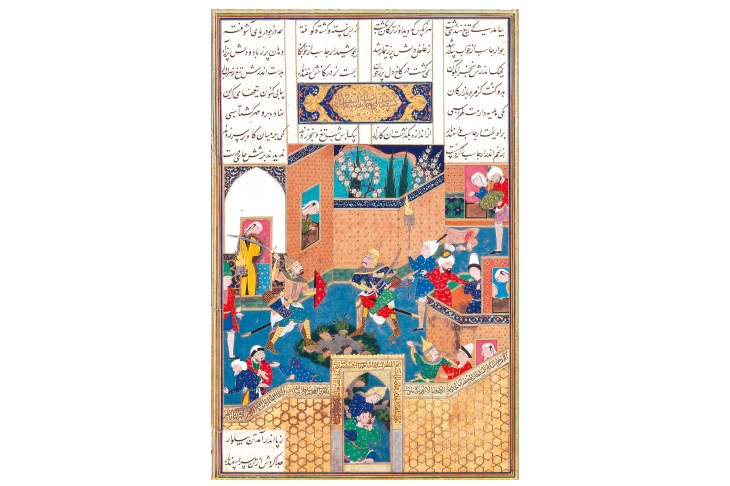The title of this book, By the Pen and What They Write, is a quotation from the Qur’an and comes from the opening of the ‘Surah al-Qalam’ (Chapter of the Pen), in which the authority of the cosmic scribes in heaven, whose writing determines the fate of humanity, is invoked in order to authenticate the revelation that follows. According to Islamic tradition, the Prophet Muhammad was illiterate (and so presumably were most of his audience).
So it is odd to find writing featuring so prominently in this surah and throughout the Qur’an. Prior to the revelation of the Qur’an in the seventh century, the only texts that have survived in the Arabian Peninsula are brief, unargumentative rock inscriptions and many of these are in languages or scripts other than Arabic. So, as Angelika Neuwirth, one of the distinguished scholars to contribute to this volume, observes:
It is a striking fact then, that the Qur’an appears — seemingly — out of the void, as a fully fledged discursive text, extensive in range and replete with philosophical and theological queries.
The Bible consists of many diverse texts by diverse hands that have been assembled over the centuries. The Qur’an is not like that. Its message is held to be eternal, inimitable and untranslatable, and it was revealed to just one man in a matter of decades.
As a consequence, the Arabic language and script had and still has a special prestige among Muslims. That prestige had been increased towards the end of the seventh century when the Umayyad Caliph, Abd al-Malik, decreed that Arabic should be the sole language of administration in the Muslim empire and that its currency should bear Arabic inscriptions. Ambitious Nabataeans, Persians, Copts and others hastened to learn the Arabic language and script. Arabic became the major language of international commerce.
Baghdad, a city with a population many times that of medieval London and Paris combined, had an unprecedentedly large literate population. Because of this, and because of the replacement of expensive parchment by paper, literature flourished under the Abbasid caliphs from the late eighth century onwards. Hugh Kennedy concludes his chapter entitled ‘Baghdad as a Centre of Learning and Book Production’, with these resound-ing words:
I should like to argue that Abbasid Baghdad was probably the first place on the planet where an author could make a living, not by being independently wealthy or having a wealthy patron, or even being part of an institution like a monastery that subsidised his activities, but by writing books to be sold in the market to a literate public.
‘The past is a foreign country: they do things differently there.’ What was true of L.P. Hartley’s presentation of Victorian England was even more the case for the medieval Arab book world. There almost everything was done differently. Arabic script runs from right to left and this had consequences for the ‘reading’ of the visual arts. In cases where a narrative sequence of actions was presented in a single miniature painting (and this was often the case with Persian miniatures) one ‘read’ the visual story from right to left.
Similarly the elaborately carved iconography on the exterior of an ivory casket would be read by turning the object anti-clockwise. Books were shelved horizontally one on top of another, rather than vertically. They were not bound in such a way as to open flat on a table, without damaging the spine at least, and hence a rahl, an x-shaped piece of furniture was used to support a large book in use, rather than the western lectern.
If multiple copies of a text were required, then dictation was preferred to direct copying from the manuscript. There are no capital letters in the Arabic script. On the other hand, letters are liable to change shape depending on whether they appear at the beginning, the middle or the end of a word, and this created problems in the early days of printing in the Ottoman empire. In the strictest sense the Qur’an was not a book, for the Qur’an more properly refers to recitation of its text. And so on.
It is impossible to turn the pages of By the Pen and What They Write without registering the confidence, leisure and playfulness of medieval Islamic literary culture, with its riddling games, literary picnics and drinking bouts. Yet it is also difficult to read this book without becoming depressed at how much has been lost. The House of Books in Abbasid Baghdad contained more than 10,000 manuscripts, but it was burnt down during the Seljuk invasion and only a few volumes survived. The Fatimid library in Cairo contained tens of thousands of volumes, yet only two manuscripts from that library are known to be extant. Ibn Muqla (d. 940) was the most famous and influential of all Arabic calligraphers and yet not one single manuscript by his hand seems to have survived. But what has survived is marvellous and it seems appropriate that a book devoted to the arts of the book should be a ravishing work of art in its own right. Tributes are due to Yale’s designer, Gillian Malpass.






Comments